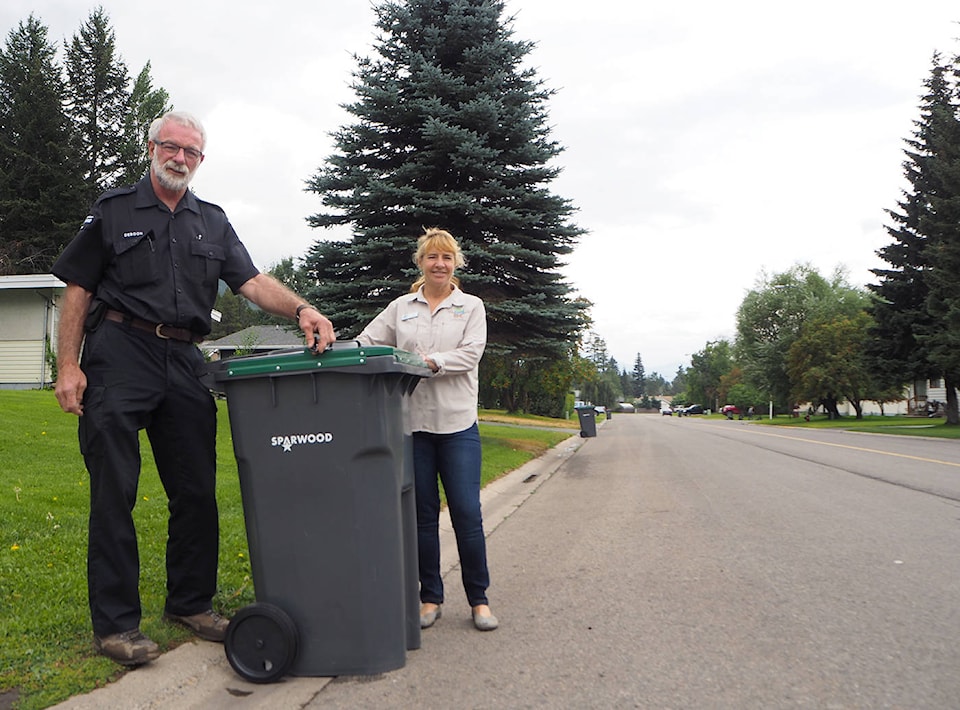Sparwood has been hailed as a leader in reducing human-wildlife conflict as new garbage bins are rolled out across the town.
It is believed to be the first community in the East Kootenay to issue every resident with a certified bear-resistant cart in what has been described as a “huge step forward” for the District.
“This is certainly a great opportunity for Sparwood to set a precedent for other B.C. communities in mitigating human-wildlife conflict,” said WildSafe BC community coordinator Kathy Murray.
Delivery of the 242-litre carts began on Monday with changes to curbside garbage collection services in Sparwood to be rolled out next month.
Murray said the bins had been tested at BC Wildlife Park in Kamloops and were certified bear-resistant.
“What that actually means is that it’s a container that’s been tested with bears. Bears are given one hour of constant contact with the bin, if they’re not able to break into it, it is certified bear-resistant,” she said.
The new carts have metal reinforcements as well as metal clasps that should prevent bears and other wildlife from breaking into them.
“If you’re in a situation where you need to keep your garbage outdoors between collection days, these bins provide additional barriers,” said Murray.
“Providing that the clasps are done up and that the area around the bin is kept clean and odour free, that will reduce the temptation for bears to break in.”
However, Murray reminded residents that nothing is bear-proof and to keep the clasps done up and the carts inside, where possible, between collection days.
District of Sparwood bylaw officer Frank deBoon said this would be the biggest issue as the new carts were rolled out and people learned how to use them.
“It’s important to keep those garbage cans clasped, so the bears don’t learn to feed on them,” he said.
The District is in the process of rewriting bylaws relating to wildlife attractants following the introduction of the new carts.
Fines for attracting wildlife currently start at about $100.
“We’ll do enforcement right away to get people on board and to accept the new system and make sure that it works for the bears and the community,” said deBoon.
He said compliance so far this year had been “fairly good” and urged residents to remain vigilant as the berry crop dries up and bears move back into town.
During his long career with the Conservation Officer Service (COS), deBoon had to destroy many bears that had become accustomed to human food.
“It’s a really hard part of the job because it’s not the bear’s fault, they’re just trying to survive by finding food,” he said.
“If you give them an easy route, they’re going to take it.”
This month, the COS has so far received more than 200 calls for black bears across the province.
Murray said calls typically peak in September, with 1200 reports of black bears recorded in B.C. in previous years.
“This year it will be interesting to see what happens,” she said.
“We did have a really good berry crop but we’ve also got smoke and forest fires, and logging and increased use of backcountry, so these are all factors that are pushing wildlife out of habitat.”
Murray said the best way to keep people safe and prevent the needless destruction of bears is to keep garbage locked up and trees free of fruit.
“If there’s no easy food for bears in town, they are more likely to move on back to the wilderness,” she said.
“The reason we tend to focus on garbage is that when people make calls to the CO Service, the majority of the calls cite garbage as the attractant, usually it’s 60 per cent of calls.”
For more information on the new carts, visit Sparwood.ca.
For advice on how to use them, visit Thefreepress.ca.
